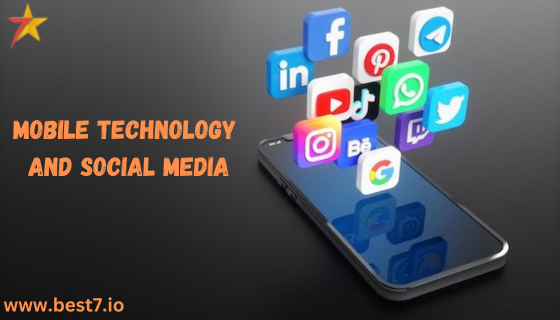
In the current landscape, mobile technology and social media are fundamentally reshaping communication dynamics. The integration of these two forces has transformed how individuals interact, share information, and build relationships. As smartphones become ubiquitous, the impact of mobile technology on social media communication is profound, enabling real-time interactions and fostering connectivity in the digital age.
The Rise of Smartphone Usage and Its Impact on Social Interaction
The rise of smartphone usage has been staggering. According to Statista, over 6.8 billion smartphones are in use worldwide as of 2024. This proliferation of mobile devices has revolutionized how people communicate. Users now have access to social networking platforms, messaging apps, and content-sharing services at their fingertips, allowing for seamless interaction regardless of geographical barriers. The increasing reliance on mobile technology for social communication highlights a shift toward instantaneous and accessible forms of interaction.
Social Media’s Transformation of Communication Dynamics
The social media impact on communication dynamics is evident in various aspects of daily life. Traditional methods of communication, such as phone calls and face-to-face meetings, are increasingly supplemented or replaced by digital interactions. A report by Pew Research indicates that 72% of American adults use at least one social media platform, showcasing the widespread adoption of these tools for social interaction. This trend signifies a notable evolution in how individuals connect with one another.
The Shift Toward Visual Communication
Digital communication trends demonstrate a marked preference for visual content. Platforms like Instagram and TikTok prioritize images and videos, leading users to communicate through engaging visual formats. According to HubSpot, 54% of consumers prefer to see video content from brands they support. This shift in communication style reflects the evolving preferences of users and highlights the importance of adapting to new methods of expression in the digital landscape.
Real-Time Interactions: A Hallmark of Mobile Technology
The effect of mobile technology on communication is demonstrated not only by the popularity of social networking sites but also by the emergence of real-time interactions. Instant messaging applications, such as WhatsApp or Facebook Messenger, enable users to engage in conversations immediately. According to Statista, more than 2 billion people use messaging apps throughout the world. This ability to stay in touch improves connectivity and makes it possible to share thoughts and experiences with friends or loved ones.
Online Relationships: Bridging Distances but Not Without Challenges
Online relationships that people establish contribute to the changing nature of social interactions. By interacting with others online, users facilitate communication and can stay in touch with people who live in other countries. Although it creates a greater sense of community and makes a person feel more appreciated, there are some limitations to this effect. Online relationships are not as meaningful as real-life ones, and the lack of face-to-face communication may affect the ability to establish a bond between people.
User-Generated Content: Empowering Communication and Marketing
The effect on communication development, achieved through the use of mobile technology and social networking sites, is the creation of user-generated content. YouTube, TikTok, or Twitter are platforms that allow one to share their thoughts, engage audiences, or create videos or other types of information. A report by the Digital Marketing Institute indicates that 86% of businesses use user-generated content in their marketing strategy.
Mobile App Communication: Redefining Accessibility
The role of mobile app communication is another important trend among the discussed ones. Several social media apps have designed their own in order to improve user services. It allows people to access more comfortable information and other users on a real-time basis. According to eMarketer, consumers are now spending more than 5 hours per day on their mobile devices, with smartphone apps accounting for half of that time.
Barriers and Challenges in Digital Communication
Foremost, communication barriers may appear as a result of people’s availability difficulties. Digital communication is rapid, and currently, people are paying less attention to slower responding messages, while incomplete messages get ignored or otherwise forgotten. Additionally, texting changes the way messages are perceived compared to talking.
The Impact of Mobile Technology on Content Interaction
Mobile devices and social networks also affect how people interact with content. Nowadays, news or opinions can easily spread on social networks; nevertheless, the mass of information may confuse or distort the truth.
Mobile Technology in Collaboration and Industry Applications
On the other hand, mobile technology improves communication in numerous ways. Instant access to others fosters collaboration, mainly through the availability of information. For example, through platforms like Zoom and Microsoft Teams, virtual meetings have become a commonplace practice.
Future Trends: AR, VR, and Social Media Integration
In my personal opinion, among the future trends, social media platforms will integrate more features that ensure active user participation with the content. These technologies will include AR and VR, allowing users to consume media in immersive formats.
Gaming as a Social Communication Medium
Social communication through gaming among the mobile gaming community is another area where present-day communication dynamics have caused a shift. Platforms like Discord enable casual chatting and exchanging ideas, fostering connections among gamers.
The Power of Comparisons and User-Generated Content in Decision-Making
Comparison of tech products is poised to continue to impact the decision-making of the generation. The reliance on user-generated content transforms the way brands interact with consumers.
The Evolving Landscape of Communication
In summary, the inexorable advance of mobile technology and its intersection with social media will lead to the enhancement and transformation of communication. The combined power of mobile technology and social media is reshaping the way humans communicate, forging more flexible and efficient channels of interaction.












